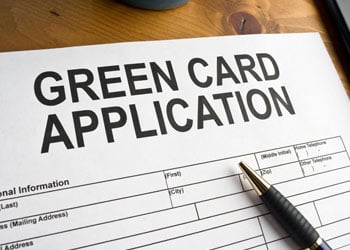|
Home > Green Card Application Green Card ApplicationGreen Card Application Process:A green card is a document that allows you to be a legal permanent resident in the United States. This page details the general information, as well as links to additional and more specific information you may need during your application for permanent residence. 
Am I Eligible to File for a Green Card?There are four main categories that people are allowed to file under for a green card. They are based upon family, employment, humanitarian need or under a category for special immigrants: Family Based Green Cards:Relatives of a United States citizen are eligible for permanent residence in the United States and may apply for the appropriate visa and green card. Depending upon how close a relative is they may be afforded an easier time with obtaining a green card. More information on family based green cards can be found here. Employment Based Green Cards:You may wish to work within the United States as an immigrant and in this case you would apply for an employment based green card and your sponsor--instead of a family member--would be your employer. If you are looking for an employment based green card click here. Or, if you would like to work in the United States as a non-immigrant (meaning that you do not intend to be a permanent resident) . Humanitarian Basis for Green Cards:People attempting to escape political or religious persecution within their country should apply for a green card as a refugee or an asylee. If you have been granted either refugee or asylee status by the United States government you will be eligible to apply for a green card one year after you were given that status. If you are a refugee you must apply for permanent residence, but it is optional if you claim asylum. However, it is likely that if you have either status you might want to consider remaining in the united states on a more or less permanent basis. Other Ways to get a Green Card:There are many other ways by which you can apply for a green card. Some of your options are if you are:
It is important to note that you will still have to demonstrate that you meet the government's requirements for these various documents and if you are not able to your request will be denied. Being conscientious and attentive is imperative to the process. How do I obtain a Green Card?There are three ways by which you can apply for a green card: adjustment of status, consular processing and concurrent processing. Applying for a Green Card Based on Adjustment of Status:You may already reside in the United States on a temporary basis and wish to become a permanent resident. If this is the case you would file for an adjustment of status.
Applying for a Green Card through the Consular Process:Say you want to apply for permanent residence outside of the United States, in this case you cannot apply for an adjustment of status. Rather you would have to go through consulate processing. This means that your application for a green card would be submitted to the consulate or embassy within or near your country of citizenship.
Concurrent Filing: Filing for your Green Card and Immigration Petition Concurrently:Certain categories of immigrants may file concurrently. This means that you can petition for immigration, register your permanent status, submit all required documentation and pay all of the fees at the same time.
Visas:Although immediate family visas have no limit to how many may be granted, all other immigration visas do. These limitations depend upon what country the applicant is from as well as an overall cap. There are only 226,000 visas distributed for family based applications and 140,000 visas for work based applications per year. If your visa is considered one of the preference categories you must wait until your priority date becomes current. Only when that date comes up are you allowed to actually apply for the immigrant visa. Your priority date is included in Form I-797 which is the form that your sponsor filed on your behalf. The Employment Authorization document (EAD):If you are neither a permanent resident nor a citizen, but still wish to work, especially when waiting for your green card, you will need to obtain an Employment Authorization document by filing the I-765 form. This document is good for one year and then you will have to renew it. The earliest you can apply for a new EAD is 120 days from its date of expiration. Green Card Medical Examinations:You will also need to undergo a medical examination to be granted permanent status in the United States. This medical examination must be completed by a doctor who is designated by the USCIS as a civil surgeon. You must contact the USCIS to find one of the approved doctors so that your examination will count towards all the necessary requirements. |